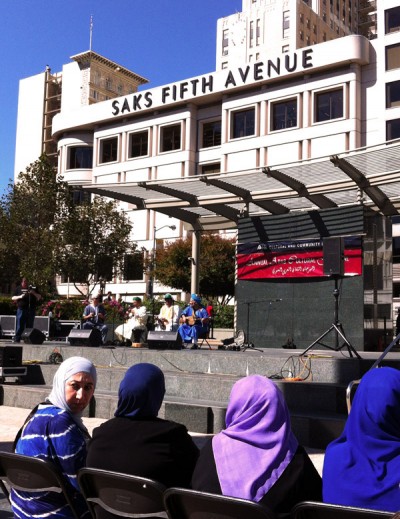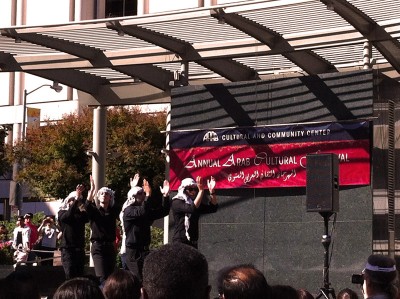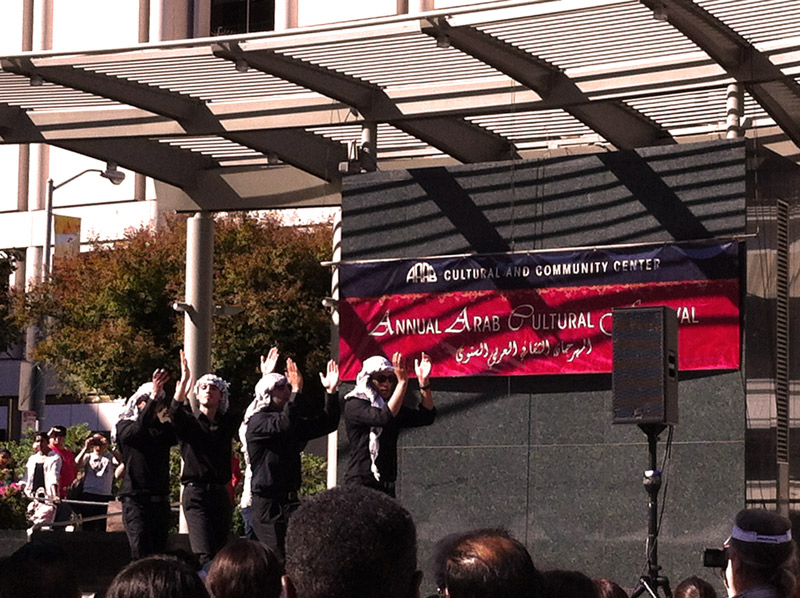
On one of the hottest days of the year in San Francisco, a whirlpool of polyester hijabs, Gucci sunglasses, and strollers surround the Dewey monument pillar in Union Square. A stage in the shade of Saks Fifth Avenue is draped with a vermilion banner reading, “19th Annual Arab Cultural Festival.” Every October since 1995, the Bay Area’s Arab Cultural and Community Center celebrates its heritage through food and performance. Slipping past grandmas and throngs of young men with shiny black hair, I take a sweep of the stands: Falafel, henna, what my Israeli stepmother would term chachkis, and information booths—the majority of which are Palestinian related.
The program opens with the first Palestinian hip hop group to rap in Arabic, DAM (Da Arabian MCs) from Lod. Together for over a decade, they were originally inspired by Tupac. They found the street scenes in his music videos comparable to their own hometown slums. Their recent 2012 album, Dabka on the Moon, has received international attention. The group begins singing their first song, “I’m not a traitor.” I can only catch one word, “Britania.” They rouse the crowd to clap and repeat the hook, Ana mish khayn (I’m not a traitor.) I shift uncomfortably. I can’t say it. So I move to an empty henna stand. I sit down and a woman squeezes a wet design across my knuckles. The girl next to her has a Palestinian flag peeking out of her hijab. She asks how I heard about the festival and I mention that I’m learning to speak Arabic.
“May I ask why?”
“I’ve loved Middle Eastern culture since I was small,” I tell her.
“What kind of culture?”
“Middle Eastern,” and then I realize it’s hard to explain. Suddenly, she points and laughs. A mother is holding a baby in a blue onesie that reads, “I hella love my homeland.”
“Aw, that’s cute,” she chuckles.
I smile too; it’s hard to do anything else at a bouncing baby. Suddenly the song changes and this time it’s in English. Boy meets girl in an elevator. Electricity. Flirtation. The singer cries out, “I fell in love with a Jew!” I grin ear to ear and the crowd laughs. I relax, things are not as black and white as they seem, and the world opens up again.
The next performer is dressed in traditional Moroccan garb, his rasping voice and repetitive rhythms sound more African than Arab.
“What is this?” a miffed older man asks me in a thick accent, palm angled to the sky.
“Om Kalthoum,” I joke. She was Egypt’s international megastar.
He scoffs and walks away.
He’s right. There’s something off about the program. Some of the acts don’t exactly match up with the Arab culture I’ve experienced both in the States and abroad. They’re too politically correct. Their air of universal sophistication comes off as a bit naïve.
The girl sitting next to me introduces herself. She’s originally from Cambodia, but has been living in the States for a couple of years. She’s now here for a class on demystifying the Middle East. She starts asking questions and I have a few answers, because I studied and lived in the region for eight months. The conversation moves from burqas, to food, to religion, and then,
“What’s your ethnicity?”
“Jewish,” I tell her.
“Oh I see. Do you have your own language or speak Arabic?”
“It’s called Hebrew.”
“I see. Are Jews and Muslims the same over there, this class is so confusing.”
“Not quite.”
Then a Dabka group takes the stage. Young men in black dress shirts and pants line up, hands clasped. Synth accordion, violin, and tabla blares out of the speakers. Auto-tune Arabic rolls out into the city. The men begin moving right and left, switching off who leads. Their black and white checkered keffiyahs flutter as they jump, stomp, and swing a cane. Dabka is essentially Arab folk line dancing. It’s often performed at weddings and is particularly popular in Syrian and Palestinian communities. The crowd is riled up again, a sea of big lipstick smiles and strange hedge Mohawks that seem to pervade the Middle East. The previous performance is a carnival sideshow in comparison. And for a moment, I’m transported.

This is real, how the culture is experienced today, not a purist fantasy. I feel the urge to get up and dance with them, with the few steps I learned from a friend. I once helped close down a restaurant while the owner sang Arabic pop songs with large Syrian Christian families clapping and sighing, shisha smoke stuffing the room with strobe lights and brimming glasses of wine. Among these large families I felt at home, nostalgia for a culture we once and still share in some parts of the world.
In the noonday heat, visitors shoot their cameras and phones into the air to record the event. Though I’m that rare breed of San Francisco native, I’ve never felt truly at ease in the city. Perhaps it’s just the byproduct of urbanity that teaches you to always keep your guard up. But as the music rises within and outside me, the surrounding streets fade into a hush of plowed desert. Passersby turn into guests at this vibrant rip-roaring party. And I realize I’m no visitor, it feels all too familiar.
Catie Damon is a recent graduate of UC Santa Cruz.
[fbshare type=”button”]

